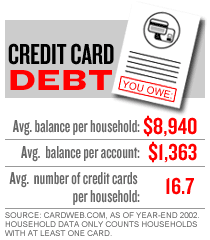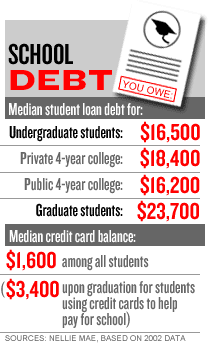NEW YORK (CNN/Money) – Carrying a big debt load can feel like
carrying a baby grand on your back.
Yet many Americans have been toting around a sizeable burden,
although they've been shifting the weight around lately. 
According to Economy.com, nationwide household liabilities have
grown 24 percent since the start of the recession, which is 10
percentage points more than during the last recession in 1991.
True, there are more homeowners today than there were in the
early 1990s, which accounts for part of the increase.
But it's also true that homeowners have been taking out bigger
mortgages than they might have ordinarily since interest rates have
been low. And they've taken advantage of rising home values to tap
equity to pay off consumer debt, such as their credit cards and
cars.
That's a good news-bad news scenario. On the one hand, "People
have improved their balance sheets because the mix (of debt) is
better," said Brian Nottage, Economy.com's director of
macroeconomics. "If people are going to rack up debt, better that
it's mortgage debt."
That's because interest rates on home equity lines of credit
(HELOCs) and mortgages tend to be much lower than credit card debt,
and the interest payments are usually tax deductible. And since the
risk of not paying what you owe on home debt means you could lose
your house, there's more incentive not to default, Nottage said.
On the other hand, there can be risk in such a mix when rates
rise.
The rates on HELOCs and adjustable rate mortgages (the loan sizes
of which have tended to be much larger than fixed-rate mortgages
lately) will adjust upward. So a homeowner with an ARM and a HELOC
could see his debt payments shoot up dramatically in the span of 12
months if rates go up a few percentage points.
Add to that the risk of losing a job, or home prices cooling off,
and some consumers could find themselves in a tight squeeze fast
unless they've managed to work their debt levels down to manageable
levels.
Love affair with plastic (cont.'d)
Even if Americans have improved their debt mix, it's not exactly
as if they've wiped out their credit card debt altogether. 
At the end of 2002, among households with at least one credit
card, the average balance was $8,940, according to CardWeb.com.
That's pricey debt. Despite record lows in interest rates, credit
cards haven't yielded much on the rate front. In fact, credit card
interest rates have been averaging around 16.2 percent lately.
And many households have far more than one credit card. The
average total is a whopping 16.7 – typically that's six bank cards,
eight retail cards, and two or three debit cards.
Cars, cars, cars
Americans' love affair with their cars also has been going full
throttle. Auto sales have been at or near historically high levels
in the past five years.
And consumers have paid more for the privilege of owning a set of
wheels. 
According to the Consumer Bankers Association, the average size
of a new vehicle loan increased 5 percent to $21,779 in 2002. The
average size of a used vehicle loan rose 12 percent to $16,542.
There is also a trend toward longer-maturity loans – 49 months or
longer is now typical for the vast majority of auto loans.
But consumers have been handling their car debt a bit better:
Loan delinquencies have decreased this year compared with 2002.
Students pay more
College prices have been rising at higher than historical rates,
particularly at public universities. And that's translated into far
bigger debt burdens for students.

Since 1997, the median in undergraduate student loan debt has
risen 74 percent to $16,500, according to Nellie Mae's 2002 National
Student Loan Survey.
And the gap in debt loads between students who attend four-year
private colleges and those who go to four-year public universities
has narrowed. Median debt for undergrads at public institutions grew
67 percent since 1997, while the median debt for undergrads at
private colleges rose only 32 percent.
Grad students also have seen their debt levels jump. They now
borrow an additional $31,700 on average on top of their undergrad
loans, a 51 percent increase since 1997. Their median debt level is
now $23,700, an increase of 72 percent in five years.
On the plus side, thanks to record low interest rates and more
flexible payment plans, the increase in student-loan monthly
payments hasn't been as dramatic as the jump in debt levels. The
average payment on undergrad debt in 2002 was $182, up 13 percent
from the $161 owed in 1997.  | 
